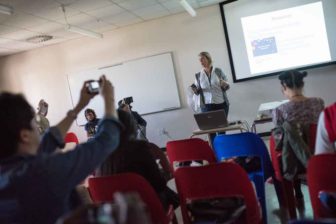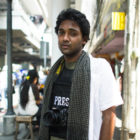
Ingrid Kopp, c0-director of Electric South. Picture: Daylin Paul
The “second wave of VR” has made the tools and software needed to make VR content a lot more affordable and a lot easier to use, said Ingrid Kopp, co-director of Cape Town-based Electric South. Kopp was speaking at the Global Investigative Journalism Conference in Johannesburg on Friday.
“It’s now a mistake to think that virtual reality reporting is expensive, or more expensive, than traditional video reporting. It can be expensive, but it can also be relatively cheap.”
She said that historically people in Africa didn’t have the broad access to tools and software to make VR content, but decreasing prices mean that good quality 360-degree cameras can cost less than $200, making them more accessible.
She said that it was useful to have a “hacking attitude” when working with VR in Africa.
“We can’t always have the fanciest gear. But we’re good at hacking what we have into something new.”
The New New Wave of VR
At the other end of the spectrum, Cassandra Herman, a producer and director at Emblematic Group, is working with a range of emerging VR technologies that produce high-quality VR content. Her documentary, After Solitary, about being in solitary confinement, uses a combination of volumetric capture and photogrammetry.
For the documentary, Herman’s team took thousands of photographs using a DSLR inside the solitary confinement cell. Using photogrammetry, they precisely map the photos onto a 3D mesh, to reconstruct the cell.
They then interviewed the subject of the documentary in a green room using an array of 40 cameras, a technique known as volumetric capture. This creates a hologram of the subject which is then placed into the 3D mesh using the Unity game engine.
This creates an extremely high-quality VR experience but, said Herman, “it involves a lot more heavy lifting than standard 360-degree filming.”
Although this type of technology was still relatively expensive, she said, more affordable versions of it, such as DepthKit, are starting to emerge.
VR in Disasters
Qiu Jiaqiu, the founder of Real Image Media in China, said his company had produced more than 100 pieces of non-fiction VR content, much of it around disasters. In most cases they used drones to capture footage of these disasters. One particularly use of this technique, he said, is that they are then able to use the footage to get input from experts who are able to view the disaster scenes remotely.
Jiaqiu also said that 360 video makes it easier for them to quickly capture scenes. In one case, following a disaster, he was able to enter the area disguised as an aid worker and was able to quickly capture the scene using a 360-degree camera.
Ethics in VR
There were, however, ethical considerations when producing VR content, said Herman. The format was extremely immersive and could have a very real emotional effect on its viewers. She warns that while there was potential for shock value in VR, this must done cautiously.
Kopp said there were also ethical considerations around filming people without them being aware of it. She said that while VR was excellent for filming crowds it did mean you were filming people who have no idea if the camera is focused on them.
Jiaqiu said that even though the technology had advanced, the rules and ethics of journalism still applied.
Out of Reach for Many
One of Kopp’s major concerns, however, was how accessible VR content is. Data is prohibitively expensive in many parts of Africa, said Kopp, and that is a major hurdle to the development of VR on the continent. “The phones we don’t have to worry about, it’s the data we have to worry about.”
VR creation and editing tools
– Mistika for image stitching
– Kolor Autopano for image stitching/panoramas
– Reaper for sound
– Audio Ease 360Pan for ambient sound editing
– Depth Kit for image stitching
 Alastair Otter is the managing partner of Media Hack Collective, a data journalism and data visualization initiative based in Johannesburg. He is the former editor and head of editorial innovation at Independent Online, one of Africa’s largest online news sites. At Media Hack, he handles data visualization and the development of online media products.
Alastair Otter is the managing partner of Media Hack Collective, a data journalism and data visualization initiative based in Johannesburg. He is the former editor and head of editorial innovation at Independent Online, one of Africa’s largest online news sites. At Media Hack, he handles data visualization and the development of online media products.
 Daylin Paul is an independent photographer, visual journalist and photojournalism educator based in Johannesburg. He is the 2017 winner of the prestigious Ernest Cole Award for Photography for his ongoing documentary Broken Land and the 2017 Hostwriter Pitch Prize for Collaborative Journalism. His work has appeared in The New York Times, The Guardian, Foreign Policy, Financial Times and Huffington Post.
Daylin Paul is an independent photographer, visual journalist and photojournalism educator based in Johannesburg. He is the 2017 winner of the prestigious Ernest Cole Award for Photography for his ongoing documentary Broken Land and the 2017 Hostwriter Pitch Prize for Collaborative Journalism. His work has appeared in The New York Times, The Guardian, Foreign Policy, Financial Times and Huffington Post.
